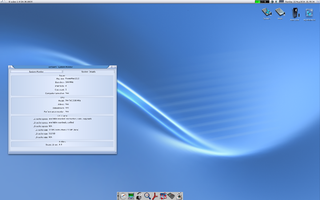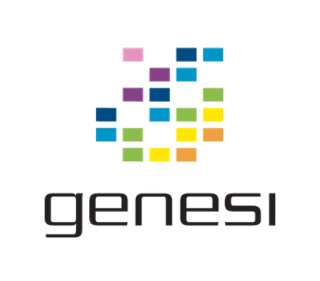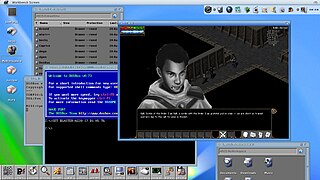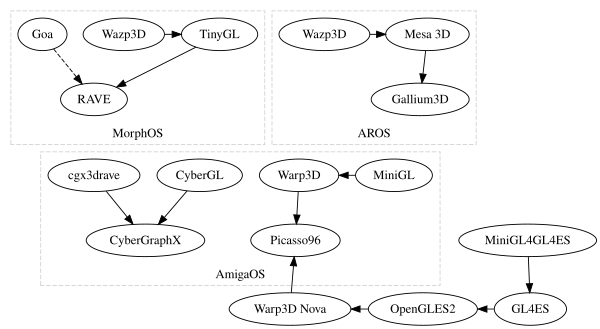
Amiga is a family of personal computers introduced by Commodore in 1985. The original model is one of a number of mid-1980s computers with 16- or 16/32-bit processors, 256 KB or more of RAM, mouse-based GUIs, and significantly improved graphics and audio compared to previous 8-bit systems. These systems include the Atari ST—released earlier the same year—as well as the Macintosh and Acorn Archimedes. Based on the Motorola 68000 microprocessor, the Amiga differs from its contemporaries through the inclusion of custom hardware to accelerate graphics and sound, including sprites and a blitter, and a pre-emptive multitasking operating system called AmigaOS.

PowerPC is a reduced instruction set computer (RISC) instruction set architecture (ISA) created by the 1991 Apple–IBM–Motorola alliance, known as AIM. PowerPC, as an evolving instruction set, has been named Power ISA since 2006, while the old name lives on as a trademark for some implementations of Power Architecture–based processors.
AmigaOne is a series of computers intended to run AmigaOS 4 developed by Hyperion Entertainment, as a successor to the Amiga series by Commodore International. Earlier models were produced by Eyetech, and were based on the Teron series of PowerPC POP mainboards. In September 2009, Hyperion Entertainment secured an exclusive licence for the AmigaOne name and subsequently new AmigaOne computers were released by A-Eon Technology and Acube Systems.

Pegasos is a MicroATX motherboard powered by a PowerPC 750CXe or PowerPC 7447 microprocessor, featuring three PCI slots, one AGP slot, two Ethernet ports, USB, DDR, AC'97 sound, and FireWire. Like the PowerPC Macintosh counterparts, it boots via Open Firmware.
PowerPC G4 is a designation formerly used by Apple and Eyetech to describe a fourth generation of 32-bit PowerPC microprocessors. Apple has applied this name to various processor models from Freescale, a former part of Motorola. Motorola and Freescale's proper name of this family of processors is PowerPC 74xx.

Ambient is a MUI-based desktop environment for MorphOS. Its development was started in 2001 by David Gerber. Its main goals were that it should be fully asynchronous, simple and fast. Ambient remotely resembles Workbench and Directory Opus Magellan trying to mix the best of both worlds.

Phase5 Digital Products is a defunct German computer hardware manufacturer that developed third-party hardware primarily for the Amiga platform. Their most popular products included CPU upgrade boards, SCSI controllers and graphics cards.

The Open Desktop Workstation, also referred to as ODW is a PowerPC based computer, by San Antonio-based Genesi. The ODW has an interchangeable CPU card allowing for a wide range of PowerPC microprocessors from IBM and Freescale Semiconductor.
The Amiga is a family of home computers that were designed and sold by the Amiga Corporation from 1985 to 1994.
The Amiga computer can be used to emulate several other computer platforms, including legacy platforms such as the Commodore 64, and its contemporary rivals such as the IBM PC and the Macintosh.
AmigaOS is the proprietary native operating system of the Amiga personal computer. Since its introduction with the launch of the Amiga 1000 in 1985, there have been four major versions and several minor revisions of the operating system.
Microprocessors belonging to the PowerPC/Power ISA architecture family have been used in numerous applications.

AmigaOS 4 is a line of Amiga operating systems which runs on PowerPC microprocessors. It is mainly based on AmigaOS 3.1 source code developed by Commodore, and partially on version 3.9 developed by Haage & Partner. "The Final Update" was released on 24 December 2006 after five years of development by the Belgian company Hyperion Entertainment under license from Amiga, Inc. for AmigaOne registered users.

Genesi is an international group of technology and consulting companies in the United States, Mexico and Germany. It is most widely known for designing and manufacturing ARM architecture and Power ISA-based computing devices. The Genesi Group consists of Genesi USA Inc., Genesi Americas LLC, Genesi Europe UG, Red Efika, bPlan GmbH and the affiliated non-profit organization Power2People.

Efika is a line of power efficient ARM architecture and Power ISA based computers manufactured by Genesi.

AROS Research Operating System is a free and open-source multi media centric implementation of the AmigaOS 3.1 application programming interface (API). Designed to be portable and flexible. As of 2021, ports are available for personal computers (PCs) based on x86 and PowerPC, in native and hosted flavors, with other architectures in development. In a show of full circle development, AROS has been ported to the Motorola 68000 series (m68k) based Amiga 1200, and there is also an ARM port for the Raspberry Pi series.
Hunk is the executable file format of tools and programs of the Amiga Operating System based on Motorola 68000 CPU and other processors of the same family. The file format was originally defined by MetaComCo. as part of TRIPOS, which formed the basis for AmigaDOS. This kind of executable got its name from the fact that the software programmed on Amiga is divided in its internal structure into many pieces called hunks, in which every portion could contain either code or data.
WarpOS is a multitasking kernel for the PowerPC (PPC) architecture central processing unit (CPU) developed by Haage & Partner for the Amiga computer platform in the late 1990s and early 2000s. It runs on PowerUP accelerator boards developed by phase5 which contains both a Motorola 68000 series CPU and a PowerPC CPU with shared address space. WarpOS runs alongside the 68k-based AmigaOS, which can use the PowerPC as a coprocessor. Despite its name, it is not an operating system (OS), but a kernel; it supplies a limited set of functions similar to those in AmigaOS for using the PowerPC. When released, its original name was WarpUP, but was changed to reflect its greater feature set, and possibly to avoid comparison with its competitor, PowerUP.

Sam460ex is a line of modular motherboards produced by the Italian company ACube Systems Srl. The machine was released in October 2010 and can run AmigaOS 4, MorphOS, or Debian GNU/Linux.

PowerUP boards were dual-processor accelerator boards designed by Phase5 Digital Products for Amiga computers. They had two different processors, a Motorola 68000 series (68k) and a PowerPC, working in parallel, sharing the complete address space of the Amiga computer system.















